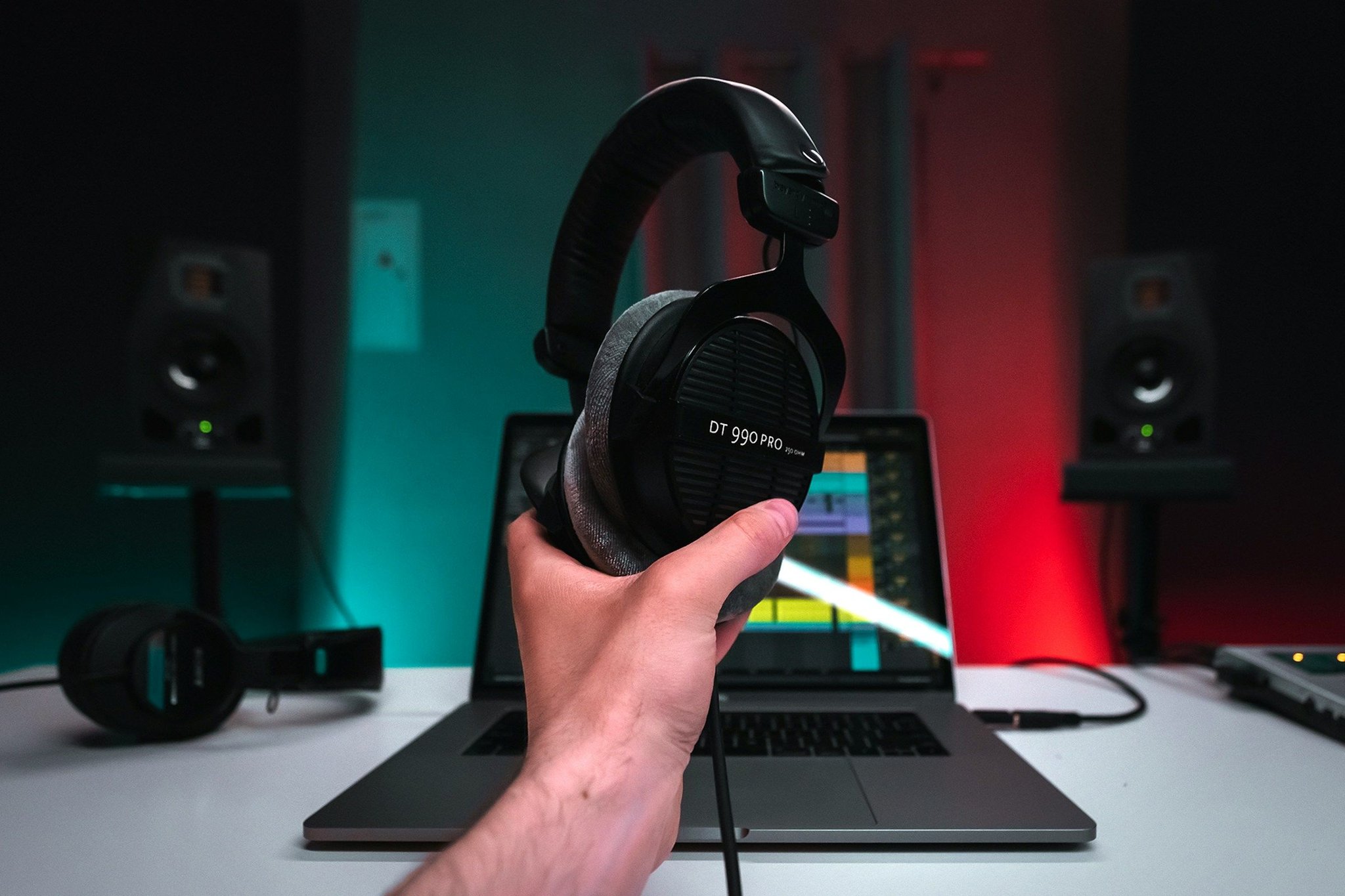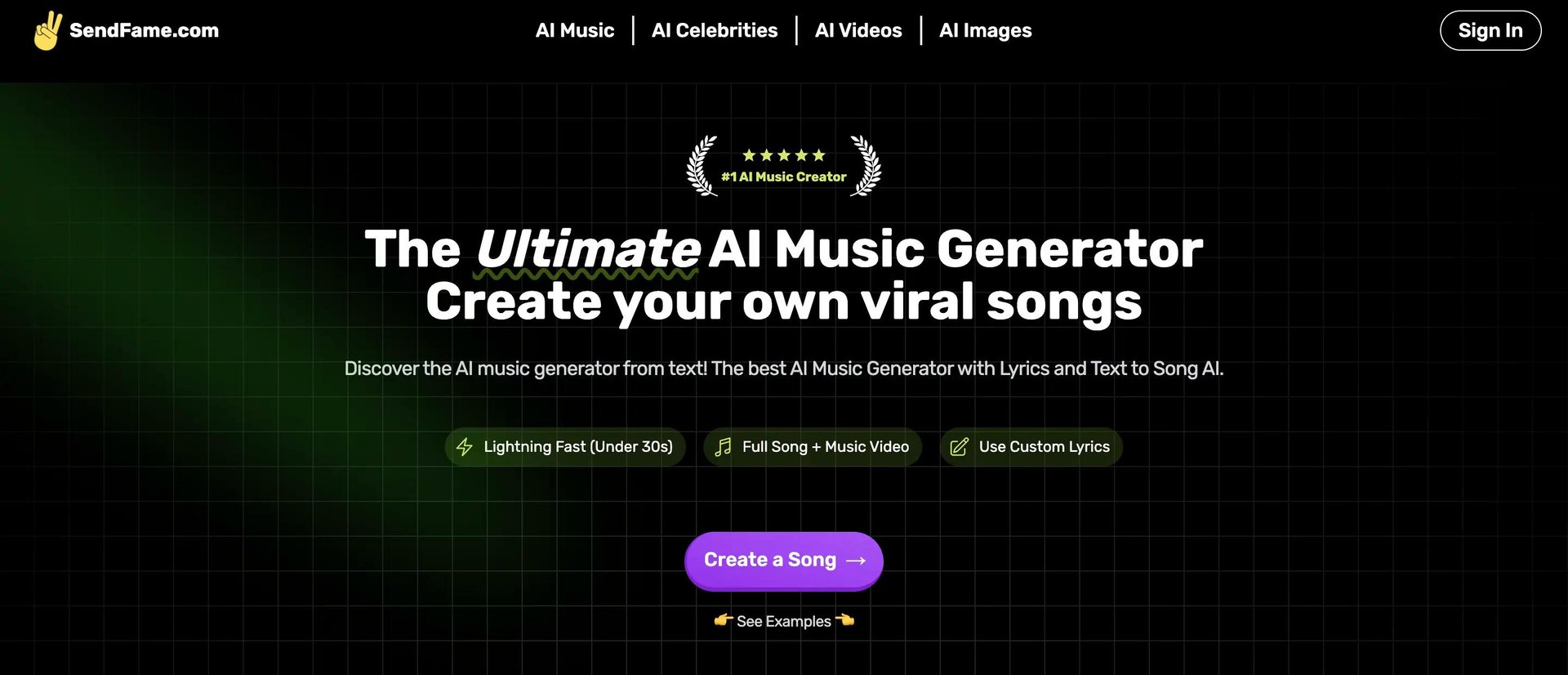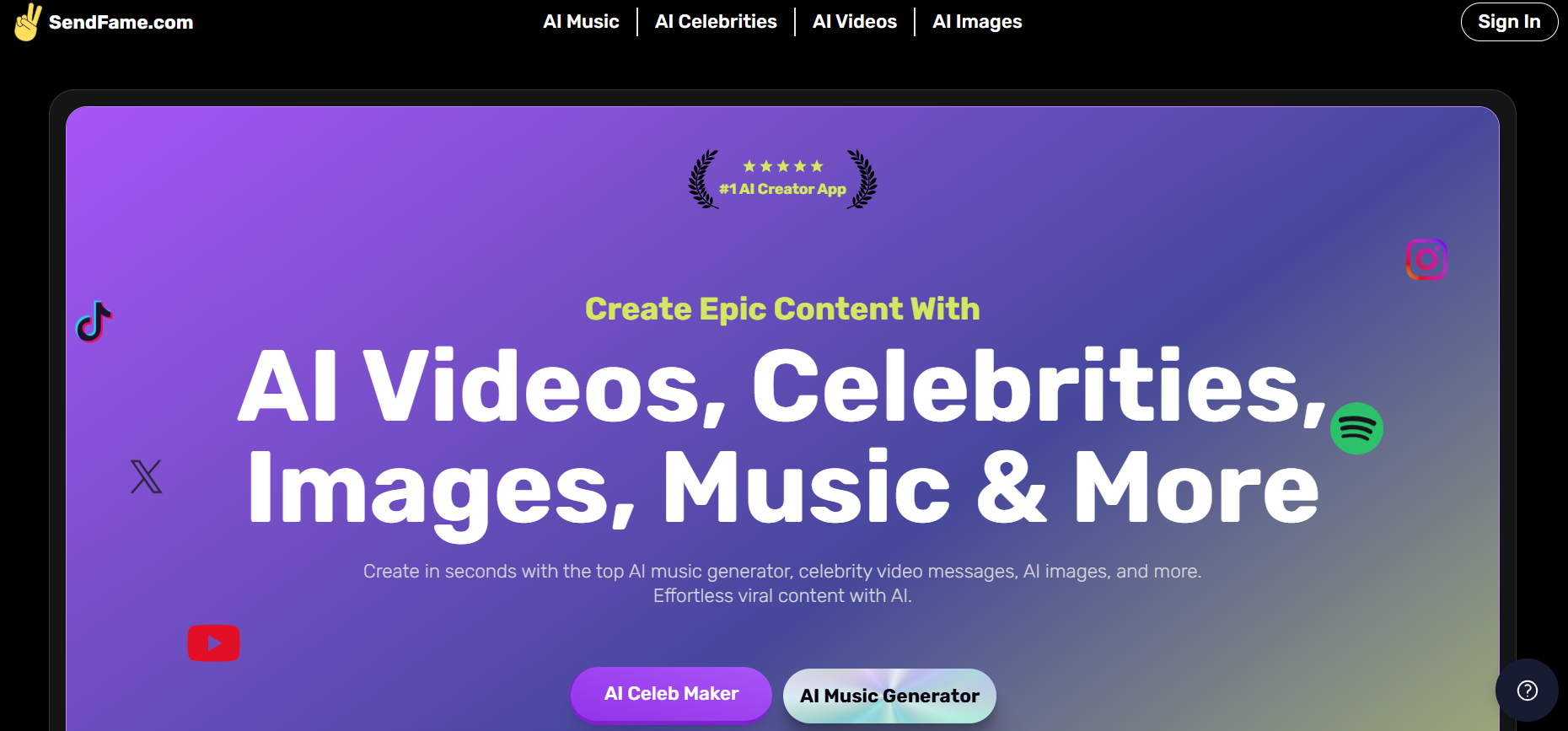What is AI Music Production?




Learn how to make AI sing a song in minutes with SendFame—fun, fast, and easy custom vocals using your lyrics and voice.
Consider this: you stumble across a song and can’t shake it from your mind. Whatever you do, it just won’t go away. Finally, you sit down at your computer to work on something, and there it is—the perfect melody to accompany your writing project.
You want to start fresh and create your version of the track, but the more you listen to the original, the more stuck you become. You realize you must let the AI sing a version of the tune first to get it out of your head and free your creative juices.
Learning how to make AI music covers could help you do just that. This guide will teach you how to make AI sing a song so you can confidently create and customize AI-generated songs effortlessly using SendFame. The SendFame solution, an AI content maker, can help you achieve your objectives of creating and customizing music covers quickly and easily. Before you know it, you will have your version of that pesky song.

An AI singing voice is a digitally synthesized vocal performance created using artificial intelligence technologies, which can mimic or generate human singing voices without requiring a live vocalist. Unlike traditional music production, which relies on recording human singers and manually processing their vocals through fixed signal processing algorithms, AI singing voices are produced through advanced machine learning models that analyze vast datasets of vocal recordings to learn and replicate the nuances of human singing.
Traditional vocal production involves capturing a human singer’s performance and then applying audio effects and adjustments using plugins based on predetermined mathematical algorithms, such as compression, equalization, and reverb, that require sound engineers to manually tune parameters. These processes are predictable but heavily dependent on the user’s expertise and do not adapt dynamically to the vocal material.
In contrast, AI singing voices are created by systems that use machine learning and neural networks to understand and reproduce vocal characteristics like pitch, tone, vibrato, and emotional expression. These AI models can generate entirely new vocal performances or clone existing voices, offering flexibility to produce vocals in multiple languages, styles, and even with unique effects that might be difficult for human singers to perform. This represents a fundamental shift from manual, static processing to intelligent, adaptive synthesis.
Machine learning forms the backbone of AI singing voice synthesis by enabling systems to learn from extensive collections of recorded singing and spoken audio. These datasets encompass a wide variety of vocal styles, tones, and emotional expressions, allowing the algorithms to identify subtle nuances in human singing. By analyzing these patterns, machine learning models develop an understanding not only of pitch and rhythm but also of the expressive qualities that make a performance feel authentic and emotionally engaging.
Beyond simply replicating notes, machine learning allows AI to mimic the dynamic fluctuations and stylistic choices that characterize human vocal performances. This means the AI can produce singing that reflects variations in volume, vibrato, and phrasing, capturing the essence of a singer’s unique delivery. As a result, the synthesized voice transcends mechanical reproduction, offering a more lifelike and artistically compelling output that resonates with listeners on a deeper level.
Voice cloning technology enables AI to create a digital replica of a specific individual’s voice by dissecting and modeling its distinctive acoustic features. Through detailed analysis of timbre, pitch range, and speech patterns, the AI constructs a vocal profile that can be used to generate new singing performances in that person’s voice. This breakthrough allows for the creation of vocal tracks without requiring the original singer to be physically present or to record new material.
The implications of voice cloning extend far beyond convenience; it opens up new creative possibilities for artists and producers. Singers can have their voices preserved digitally, enabling collaborations across time and space or even posthumous performances. Additionally, voice cloning can be used to customize vocal outputs for various applications, from personalized virtual assistants to immersive entertainment experiences, all while maintaining the authentic character of the original voice.
Neural networks, inspired by the architecture of the human brain, play a crucial role in refining AI-generated singing voices by processing audio data through multiple interconnected layers. Each layer extracts increasingly complex features from the input, such as pitch accuracy, timing precision, and dynamic expression. This layered approach allows the AI to handle intricate vocal elements that contribute to natural-sounding performances, such as subtle shifts in intonation and rhythmic variations.
By leveraging neural networks, AI systems can simulate the expressive qualities that human singers naturally produce, including emotional inflections and nuanced timing. These models continuously improve through training, learning to create vocals that are technically accurate and rich in character and authenticity. The result is a synthesized voice that feels alive and emotionally resonant, bridging the gap between artificial and human singing.
SendFame leverages these AI singing voice technologies to allow creators and producers. By integrating advanced AI models for voice cloning and synthesis, SendFame enables users to generate high-quality, realistic singing vocals without needing professional singers on hand. This capability streamlines music production workflows, reduces costs, and expands creative possibilities by allowing artists to experiment with different vocal styles and languages effortlessly. Release your creativity with SendFame!
Create stunning AI celebrity videos, music tracks, and images in seconds that will wow your audience. Generate hyper-realistic videos of your favorite celebrities delivering personalized messages, craft original songs with professional-quality vocals, and transform static images into dynamic videos—all with just a few clicks. No technical skills required—just your imagination! Join 130,000+ users already creating viral-worthy content. Try SendFame today and turn your creative ideas into reality instantly.

Begin your journey at SendFame’s AI Music Generator or AI Lyrics Generator section. You can either input your lyrics or use the AI to generate original lyrics based on your theme, mood, or keywords. Specify melody preferences or style prompts to guide the AI in composing the music and vocals. The AI analyzes your input to write music, generate lyrics, produce vocals, and create accompanying beats automatically.
Next, you’ll want to pick the vocal style. You can do this by specifying genre, gender, language, and singing style in the style or lyrics prompt. SendFame’s AI supports multiple genres such as Hip-Hop, Country, Jazz, and Pop, each influencing the voice type (e.g., urban male for Hip-Hop, soulful female for Jazz). You can also specify vocal traits like “sultry male singer,” “female narrator,” or styles such as “Gregorian chant,” “Emotional,” or “Vocaloid” to customize the AI voice. The AI automatically detects language and can switch languages mid-song without special prompts.
Through the style prompt or settings, you can adjust parameters such as pitch, tempo, and emotional tone. Use metatags to define song sections and vocal effects, such as [Diva Solo] or [Rap Verse]. Experiment with different style descriptors to achieve the desired vocal expression and musical feel.
After setting your inputs and preferences, initiate the song generation. SendFame’s AI quickly composes and synthesizes the song, which you can preview instantly on the platform. Once satisfied, download the AI-sung track in your preferred audio format. There is no limit to the number of songs you can create, and the service is free with no sign-up required.
Although SendFame primarily generates music from text and style inputs, if you incorporate your vocal recordings or audio clips, following these best practices will improve AI vocal synthesis quality:
When incorporating your vocal recordings into SendFame’s AI music generation process, starting with a high-quality microphone is essential. Professional microphones capture sound with greater clarity and precision, significantly reducing unwanted background noise and acoustic artifacts.
This results in a cleaner, more detailed vocal track that allows the AI to interpret nuances in your voice better, leading to more natural and expressive AI-generated singing. Depending on your recording environment, investing in a good condenser or dynamic microphone can make a substantial difference in the final output quality.
Beyond clarity, the microphone’s ability to handle dynamic range and frequency response also plays a crucial role. A quality microphone accurately captures the full spectrum of your voice, from subtle breaths to powerful high notes, without distortion or muffling.
This richness in the raw audio provides the AI with a more comprehensive dataset to analyze and replicate, enhancing the realism of the synthesized vocals. Proper microphone placement and soundproofing techniques minimize room reflections and ambient noise, creating an optimal recording environment for AI processing.
Maintaining clean and dry audio input is a vital step before uploading your recordings to SendFame. This means avoiding the use of effects such as reverb, delay, or heavy equalization during the initial recording phase.
These effects, while often desirable in traditional music production, can confuse the AI by introducing artificial sound layers that mask the natural characteristics of your voice. By providing the AI with unprocessed, straightforward audio, you enable it to generate clearer and more accurate vocal syntheses that retain the original emotion and tone of your performance.
Furthermore, clean audio input helps prevent muddiness and distortion in the final AI-generated track. Effects like reverb and delay can create overlapping echoes and sound tails that interfere with the AI’s ability to distinguish between different phonemes and pitch changes.
This can lead to less precise vocal articulation and unnatural sounding outputs. By keeping your recordings free from these effects, you give the AI a pure, unaltered vocal signal to work with, which improves the intelligibility and overall quality of the AI singing voice.
Pre-processing your vocal recordings with tools such as auto-tuning and noise reduction software is highly recommended to enhance the quality of inputs for AI vocal synthesis. Auto-tuning helps correct pitch inaccuracies and smooth out off-key notes, providing a more consistent and polished vocal performance for the AI to emulate.
This step ensures that the AI’s output reflects a well-tuned melody, which is especially important when generating singing voices that require precise pitch control. Software like Adobe Audition or Melodyne offers advanced pitch correction features that can be applied subtly to maintain the natural character of your voice.
Noise reduction is equally important in preparing your audio for AI processing. Background noises such as hums, hisses, or environmental sounds can distract the AI and degrade the quality of the synthesized vocals. Using noise reduction plugins or dedicated software to clean your recordings removes these unwanted sounds, resulting in a clearer vocal track.
This cleaner input allows the AI to focus on the vocal content itself rather than extraneous noise, producing more accurate and professional-sounding AI singing. Together, auto-tuning and noise reduction form a crucial part of the audio preparation workflow that maximizes the effectiveness of SendFame’s AI vocal generation.
To achieve the best possible results when using SendFame’s AI to sing your songs, ensure that your vocal style is well-aligned with the AI’s chosen voice style. This means considering the genre, emotion, and delivery of your original recordings or input lyrics so they complement the AI voice characteristics.
For example, if you want a soulful, smooth vocal output, your input should reflect that style in phrasing and tone. When the vocal style and AI voice are harmonious, the synthesized singing will sound more authentic and emotionally resonant, creating a smooth blend between your creative intent and the AI’s rendition.
Understanding the AI voice’s strengths and limitations can help you tailor your vocal style accordingly. Some AI voices excel at energetic pop or rap styles, while others are better suited for ballads or jazz. You reduce the risk of unnatural or robotic-sounding results by matching your vocal input to the AI’s preferred style.
This alignment also allows the AI to interpret better nuances such as vibrato, breathiness, or articulation, which are crucial for producing expressive and believable singing performances. Taking the time to match styles ultimately boosts your AI-generated songs' overall quality and listener engagement.
Digital Audio Workstations (DAWs) like Audacity, GarageBand, or similar software is essential for refining your vocal recordings before feeding them into SendFame’s AI system. Basic editing tasks such as trimming unnecessary silences, removing clicks or pops, and balancing volume levels can dramatically improve the clarity and quality of your input.
These adjustments help the AI focus on your voice without distractions from unwanted noises or uneven dynamics, leading to a cleaner and more polished AI vocal output. However, it’s essential to approach editing with subtlety and restraint to avoid stripping away the natural character of your voice.
Over-editing can result in a sterile or overly processed vocal track that lacks the expressive qualities that make singing compelling. Preserving natural vocal nuances such as slight timing variations, breath sounds, and dynamic shifts contributes to a more lifelike AI-generated performance.
When editing, aim to enhance clarity and consistency without sacrificing your voice's emotional depth and individuality. This careful balance ensures the AI has a rich, authentic vocal source, translating into more organic and engaging synthesized singing.
After generating your AI-sung track on SendFame, experimenting with audio filters and effects can further enhance the final product's realism and overall sound quality. Applying equalization (EQ) allows you to shape the tonal balance by boosting or cutting specific frequency ranges, helping the vocals sit well in the mix and sound more natural.
Compression can control dynamic range, smoothing loud and soft passages to create a consistent vocal presence. These subtle enhancements make the AI vocals feel more polished and professional without drawing attention to the source's artificial nature.
Using these effects judiciously is crucial to avoid overwhelming the vocals or introducing unnatural artifacts. Overuse of reverb, heavy compression, or extreme EQ can mask the delicate nuances that give the AI voice its human-like quality.
Instead, focus on gentle adjustments that complement the vocal performance and support the song’s mood. Experimenting with different combinations of filters post-generation allows you to tailor the sound to your preferences and the track's style, ultimately producing a more immersive and enjoyable listening experience.
One of the standout advantages of using SendFame for AI singing is that it allows users to create music immediately without registering an account. This smooth access means you can dive straight into composing and generating AI-sung tracks without delays or complicated sign-up processes.
By eliminating this barrier, SendFame caters to casual users and professionals who want a quick, no-commitment way to experiment with AI-generated music. This ease of access encourages creativity and spontaneity, making it an ideal tool for those who want to test ideas or produce content on the fly.
Moreover, the absence of mandatory registration protects user privacy and reduces the friction often associated with online platforms. Users can enjoy a more streamlined experience focused solely on music creation without the need to provide personal information or manage passwords.
This feature particularly appeals to individuals who value simplicity and speed, as it removes common obstacles that might discourage people from exploring AI music tools. Overall, SendFame’s no-sign-up requirement democratizes access to advanced AI singing technology, making it accessible to a broader audience.
SendFame distinguishes itself by offering completely free and unlimited use of its AI music generation capabilities. Unlike many platforms that impose usage caps or require paid subscriptions for extended features, SendFame allows users to create as many songs and lyrics as they desire without any financial commitment.
This generous policy allows musicians, content creators, and hobbyists to explore their creativity without worrying about running out of credits or facing hidden fees. The freedom to experiment endlessly encourages innovation and continuous learning in the realm of AI-assisted music production.
In addition to fostering creative freedom, the unlimited usage model supports a wide range of projects from casual songwriting to professional demos without imposing restrictions on scale or frequency. This accessibility is particularly valuable for emerging artists and independent creators who may have limited budgets but want to leverage cutting-edge AI tools.
By removing cost barriers, SendFame makes advanced music generation technology accessible to everyone, promoting inclusivity and broadening the scope of who can produce AI-driven songs.
A critical feature of SendFame’s AI singing platform is its ability to generate entirely original lyrics and melodies. The AI composes unique musical and lyrical content for each user input, ensuring that the resulting songs are fresh creations rather than reproductions of existing works.
This originality is essential for creators who want to avoid copyright complications and produce truly distinctive music. By relying on AI to craft new material, SendFame offers a reliable way to generate creative content that is both innovative and legally safe to use.
Furthermore, the generation of original content opens up exciting opportunities for personalization and artistic expression. Users can tailor themes, moods, and styles to their preferences, resulting in songs that reflect their unique vision.
This capability not only supports artistic authenticity but also encourages experimentation with different genres and vocal styles. The assurance that each output is novel and copyright-free provides peace of mind, allowing creators to confidently share, distribute, or commercialize their AI-generated music without legal concerns.
One of the most exciting features offered by SendFame is the ability to select AI voices modeled after well-known celebrities. This option adds a layer of fun and creativity to your music projects by allowing you to generate songs that sound like they are performed by famous artists.
Whether you want to experiment with a particular vocal style or create parody tracks, the celebrity voice feature provides a unique way to personalize your AI-generated music. It opens up imaginative possibilities for content creators, enabling them to produce engaging and attention-grabbing audio that resonates with audiences familiar with those iconic voices.
Beyond entertainment, celebrity voice options can also serve practical purposes in marketing, social media, or fan engagement campaigns. By leveraging these recognizable vocal styles, creators can craft distinctive audio content that stands out in a crowded digital landscape.
This feature encourages playful exploration of different genres and vocal personas, allowing users to push creative boundaries while maintaining a professional sound quality. The celebrity voice models are carefully designed to capture the essence of the artists’ vocal characteristics, ensuring that the AI-generated singing remains believable and enjoyable.
SendFame’s AI platform supports the generation of complete songs that include all the essential components such as verses, choruses, and bridges. This comprehensive song structure capability means users don’t have to piece together separate sections manually; instead, the AI composes a coherent and well-organized musical piece from start to finish.
Full song structure support is crucial for creating polished tracks that feel natural and professionally produced. It allows creators to focus on the artistic aspects of their work while the AI handles the complex task of arranging the song’s flow and transitions.
Moreover, this feature enhances SendFame's versatility for various musical styles and project types. Whether you are crafting a catchy pop tune, a heartfelt ballad, or a dynamic hip-hop track, the AI’s ability to generate structured songs ensures that the final output adheres to conventional songwriting formats.
This improves the listening experience and makes the AI-generated music more suitable for commercial release, performance, or sharing on streaming platforms. Full song structure support allows users to produce complete, ready-to-use songs with minimal effort, streamlining the creative process from concept to final product.

Creating a realistic AI singing voice starts with the quality of the input audio. You want to use the best audio samples to help the AI synthesize a natural-sounding output. This means recording your vocals with a professional-grade microphone. High-quality mics capture the nuances and clarity of your voice far better than built-in computer microphones or inexpensive alternatives.
They also minimize the intrusion of ambient sounds, reduce unwanted noise and distortion that can confuse the AI during training, and degrade the final output. Investing in a reliable microphone ensures the AI receives clean, detailed vocal data, producing more natural and expressive synthesized singing voices.
Once your high-quality vocal samples are recorded, you need to prepare them for AI voice training. This process requires cleaning up your audio files to be free from unwanted noise or effects that could confuse the AI. Here are the most effective techniques to follow:
Before uploading your vocal recordings for AI singing voice creation, it is essential to thoroughly clean the audio by removing any background noise or unwanted sounds. Advanced audio editing tools like Adobe Audition allow you to isolate and reduce ambient noise, such as hums, hisses, or room echoes, that can interfere with the clarity of your voice.
This step ensures that the AI model receives a pure vocal signal, free from distractions that could confuse the learning algorithms. Cleaner input audio helps the AI focus on the actual characteristics of your voice, resulting in a more natural and realistic synthesized singing voice.
While applying pitch correction to your vocals before training the AI model might be tempting, it is best to avoid doing so at this stage. Natural pitch fluctuations and subtle imperfections in singing contribute significantly to the expressiveness and authenticity of the voice.
If the AI is trained on overly pitch-corrected vocals, the resulting voice can sound mechanical or constrained, lacking dynamic variation. Instead, save pitch correction for the post-production phase, where you can fine-tune the output without limiting the AI’s ability to learn a versatile and emotionally rich vocal style.
When preparing your vocal samples for AI training, keeping the recordings dry and free from any added effects such as reverb, delay, or modulation is crucial. These audio effects introduce artificial reverberations and echoes that can embed digital artifacts into the training data, which may cause the AI to replicate unnatural or overly processed sounds.
Capturing clean, untreated vocals gives the AI a clear and uncolored representation of your voice. Effects and creative enhancements can be applied later in production to shape the final sound without compromising the AI’s ability to generate realistic singing voices.
Not all AI voices are the same. When creating an AI cover of a song, you want to choose or train an AI voice that closely matches the intended singing style. This helps you achieve a natural and convincing vocal performance. When the AI voice’s characteristics align with the genre or mood of the song, the output feels authentic and emotionally resonant.
For instance, an AI voice modeled on aggressive rock vocals may sound out of place or harsh when used for a gentle ballad, resulting in an unnatural or jarring listening experience. Ensuring stylistic compatibility helps the AI capture the nuances of phrasing, dynamics, and tone typical of the chosen genre, producing a more believable and artistically coherent singing voice.
Applying post-processing filters such as equalization (EQ) is a fundamental step in refining AI-generated singing voices to achieve a balanced and polished sound. You can sculpt the vocal frequency range by carefully adjusting the EQ to enhance clarity and presence. For example, using a high-pass filter helps eliminate unnecessary low-end rumble or background noise without sacrificing the essential warmth and body of the voice.
Conversely, a low-pass filter can soften overly sharp or piercing high frequencies, often a byproduct of budget microphones or digital artifacts. Thoughtful EQ adjustments ensure the AI vocals sit well within the mix and maintain a natural tonal quality.
Audio professionals consistently recommend leveraging Adobe Audition for essential pre-upload processing such as pitch correction, noise reduction, and compression to enhance the clarity and overall quality of vocal recordings. Adobe Audition’s comprehensive suite of tools allows users to meticulously clean up audio tracks by removing background noise, balancing frequencies, and smoothing out inconsistencies.
This is critical for preparing input that AI models can learn from effectively. Applying these techniques before submitting your clips to AI platforms ensures the voice data is crisp and well-defined, directly contributing to producing more natural and expressive AI-generated singing voices. The software’s flexibility also allows for iterative experimentation to find the optimal settings tailored to each unique voice recording.

SendFame stands out in the AI content creation space because of its ease of use. The platform is designed with simplicity, allowing users to generate AI-powered celebrity video messages, songs, and images with minimal effort.
Even users with little to no technical background can navigate the interface smoothly. This user-friendly experience encourages experimentation and creativity, enabling users to produce engaging content without a steep learning curve or complicated steps.
Another significant advantage that sets SendFame apart is its policy of offering free, unlimited access without requiring users to sign up. This approach removes common barriers such as subscription fees, usage limits, or the need to create an account, which often deter casual users from exploring similar AI tools.
By allowing instant access to its features, SendFame invites a broader audience to experiment and benefit from its capabilities without any upfront commitments. This open-access model fosters a more inclusive environment where creativity can flourish unhindered.
The quality of the AI-generated voice and video content on SendFame is another standout feature that elevates the platform above many competitors. By equipping advanced artificial intelligence models, SendFame produces remarkably realistic and engaging celebrity voiceovers and videos.
The platform includes well-known personalities like Elon Musk, Taylor Swift, and Donald Trump, whose voices are synthesized with impressive clarity and naturalness. This high-fidelity output enhances the authenticity and entertainment value of the content, making it more appealing for users seeking professional-grade AI creations without the complexity or cost.
SendFame’s growing user base, which exceeds 170,000 active users, showcases its effectiveness and popularity. This expanding community reflects the platform’s ability to meet diverse user needs, from casual social media enthusiasts to content creators looking for novel ways to engage their audiences.
The strong adoption rate also suggests high user satisfaction and trust, as people continue to return to the platform for their AI-generated content needs. Such a robust user presence highlights SendFame’s relevance and staying power in a competitive market.
SendFame makes it simple to create AI music covers with an easy-to-use interface and powerful tools. The first step is to choose the music you want to cover. You can start with an instrumental version of your chosen song or pick the original track to generate a custom version with a new AI voice.
Next, select your AI singer. SendFame features several realistic vocal models, including popular artists and character voices. Finally, you can customize your cover with handy text prompts and audio controls to make it unique before sharing your creation with the world.
Create Epic
SendFame